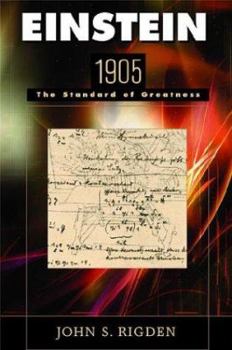Einstein 1905: The Standard of Greatness
Select Format
Select Condition 
Book Overview
An incisive analysis of the momentous theories Albert Einstein put forth beginning in March 1905, including his particle theory of light, theory of Brownian motion, and theory of special relativity, examines the context in which these ideas were presented and the impact they had and still have on society.
Format:Hardcover
Language:English
ISBN:0674015444
ISBN13:9780674015449
Release Date:January 2005
Publisher:Harvard University Press
Length:173 Pages
Weight:0.79 lbs.
Dimensions:0.7" x 5.9" x 8.5"
Customer Reviews
1 rating
Anno Mirabilis
Published by Thriftbooks.com User , 19 years ago
This year is the hundredth anniversary of "Einstein's Miracle Year" of 1905. In 1905, Albert Einstein published five scientific papers, all of which were important and three of which are still considered groundbreaking. Many scientists would consider themselves lucky to publish five important papers in a lifetime, which is one of the many reasons why Einstein's achievement is considered such a triumph. And yet, it is rare, even among the well-educated, to find people who really know what Einstein did. Words like "relativity" and "E = mc squared" are tossed around without any real comprehension of their meaning. That is why it is good and not at all surprising to find a book like Mr. Rigden's on the shelf now. In Einstein 1905, Mr. Rigden takes us through each of Einstein's papers of 1905--the quantum paper of March (often referred to as the "photoelectric effect" paper), the molecular dimensions paper of April, the "Brownian motion" paper of May, the relativity paper of June and the energy-mass paper (with that famous equation) in September. He does his best to explain exactly what it is that each paper said and, simultaneously, what Einstein was trying to achieve. (Not always the same thing.) He is even better at explaining the impact each paper had on the development of physics often far into the future and in ways Einstein both did and did not see. He also describes how many people still misunderstand what the impact of these papers is. This is by no means a book for the faint of heart. Mr. Rigden throws physics terminology around a little to easily for that. However, it is also not a book that requires a serious education in math and physics. It is very readable with hardly an equation in sight. A reader with a good general education and a desire to understand the impact that Einstein had on the world will get a lot from this book because, in the final analysis, the physics is only the means to an end here. Ultimately, Mr. Rigden is trying to get a handle on the nature of genius in his analysis of some of Einstein's greatest triumphs. Apart from Newton's flurry of brilliance in the early 1660's, there is probably not another period of time in history where so much has been achieved over such a brief period. Einstein's name has become synonymous with genius and everyone would like to know what it was that made Einstein who he was. Still, in the end, the nature of genius remains elusive. Mr. Rigden has written a great history here but is basically remains on the surface as it must in an investigation like this. One can describe how Einstein was confidently stubborn and how he worked from contradictions to "generalize it and then be guided by its implications until a resolution was found, frequently in the form of profound new insights." True as this may be (and I found his recurring discussion of the continuity/discontinuity problem in physics to be one of the most insightful things I've read recently), this doesn't always







